Note The Melting of The Battery Case
(originally published July 2012)
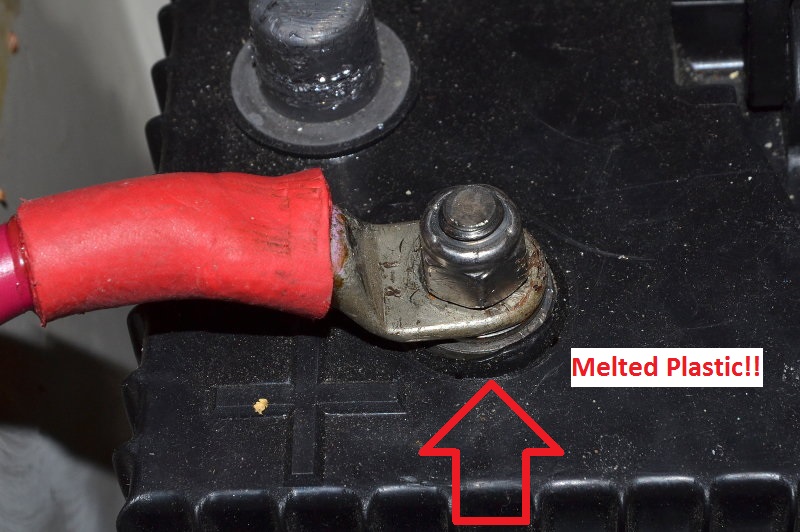
The connections to your batteries matter. How you make them, how you torque them and how clean they are all matter. Not following best practices or marine wiring standards can impact your personal safety.
While doing a winterization, and getting ready to equalize these batteries, I noticed something strange that I could not really put my finger on, then it hit me.
The battery case around the positive post was melted and uneven looking. When I grabbed the positive battery cable it was physically able to twist on the post with just minimal pressure.
Upon closer inspection it was apparent that the battery terminal had gotten so hot that it began melting the plastic of the battery case.
Why? Read on…..
The Nyloc Nut Still Had Plenty of Resistance & “loc”
I am not one of those marine insiders who is in the camp of “Nylocs are bad on battery terminals“. This example showed that the failure mode was not in-fact the Nyloc nut. I could not back this nut off with my fingers, even after it was loosened with a wrench. The plastic battery case melted well before the Nyloc failed to “loc” / lock.
Battery cases are made of polypropylene and Nyloc nuts are made of nylon, which has a higher melting point than the battery case does.
I do prefer to see a locking washer on battery post studs but sometimes they simply don’t fit, where a Nyloc may. In either case the nut must be properly torqued to battery manufacturer specifications, this nut was not.
The nut coming loose or vibrating loose was not the problem or the root issue here. This problem was simply poor installation practices.
The issues were:
#1 The Nyloc nut was not correctly torqued and showed clear evidence of pliers or another unsuitable tool being used for tightening.
#2 The lug had a SS flat washer placed under it. A SS flat washer should never be inserted between the lug and battery terminal. It is perfectly okay to use it under the nut, but it must remain on top of the lug & never underneath the lug.
The ABYC Standard that covers this:
Below: The correct installation sequence for a battery lug. A washer never goes between the lug and battery .
Why no Stainless washers between the lug & battery?
Below is a chart showing the conducting properties of varying metals. As can be seen, stainless steel is a very poor conductor.. A stainless washer creates high resistance, which leads to heat..
Holy meltdown Batman
This image represents the inherent failure potential when we connect our battery banks to high current devices such as large inverters, alternators or large inverter /chargers and we slap a washer in between the battery and the lug.
Image courtesy Heritage Marine Electrical
Nyloc Nut Deep-Dive….
I hear and see it stated quite frequently on the interweb not to use Nyloc nuts on batteries. The supporters then trumpet this around thenet as fact without doing any sort of critical thinking. Unfortunately, they line up to defend this sentiment without doing any sort of research or examination of actual facts. Okay fine, it’s the internet. So, let’s examine this a bit..
Safe Working Range vs. Melting Point
First and foremost, nyloc nuts, jut like split washers, are a one time use product.
The Nyloc nuts we use at Compass Marine Inc. are rated to 140C for the safe working range or “operating temperature range”. This is 284F.. If your batteries get to anywhere close to 284F you have other major issues to deal with! To put this into perspective, even the best marine UL 1426 battery cable is rated to just 105C or 221F. Sadly there are still thousands and thousands of boats out on the water, built in the 70’s & 80’s, using 60C / 140F rated battery cable, sad but true. If the Nyloc in the nut will melt and cause a failure then I suppose we may all need at least 140C rated marine wire too?
Of course we can’t just look at the safe working range if we want to see the point where an actual total failure might occur. Where would that likely occur? Probably somewhere well above the 284F safe working temp and closer to the melting point for the nylon 66, which is used in Nyloc nuts.
 The actual melting point of the nylon 66, used in Nyloc nuts, is 515.9F. For examination purposes however, we can still use the safe working temp of 140C/284F. What if you have soldered battery lugs? If you do, it is quite probable that you have a solder that actually melts at a lower temp than Nylon 66 does.. Yes, you read that correctly. Many electrical grade solders melt at a lower temp than the nylon used in a Nyloc nut does.
The actual melting point of the nylon 66, used in Nyloc nuts, is 515.9F. For examination purposes however, we can still use the safe working temp of 140C/284F. What if you have soldered battery lugs? If you do, it is quite probable that you have a solder that actually melts at a lower temp than Nylon 66 does.. Yes, you read that correctly. Many electrical grade solders melt at a lower temp than the nylon used in a Nyloc nut does.
The point here is that the ABYC standards still allow soldered on battery lugs (with no mechanical connection eg: crimp) and the solders above are very typical of electrical work such as soldered on battery lugs..
Battery Case Melting Point?
What about the plastic used in the actual battery cases? Lead acid battery cases are made of polypropylene (PP), not nylon. Polypropylene (the battery case) actually melts at around 189F lower than the nylon 66 in the Nyloc nut does. We are seeing exactly that right here in this case. The Nyloc nut survived with plenty of locking still intact, yet the battery case had begun to physically melt.

I suppose we’d best get rid of those unsafe plastic battery cases and replace them with STEEL… Oh wait steel & acid, hmm better think this one through a bit more……..?. (grin)
What fasteners do battery makers ship batteries with?
Let’s also look at the way the vast majority of batteries for marine use actually ship to us? An insanely large percentage of “marine batteries”, even today, and our business installs hundreds of batteries still ship with hex nuts but, no locking washer. Yes, you guessed it, there is no lock washer to be found with many of the marine battery brands. Heck, there are still some brands shipping with wing nuts and no locking mechanism what so ever. The ABYC actually disallows wing nus for batteries using 6 AWG or larger wire.
Exide Marine Battery:
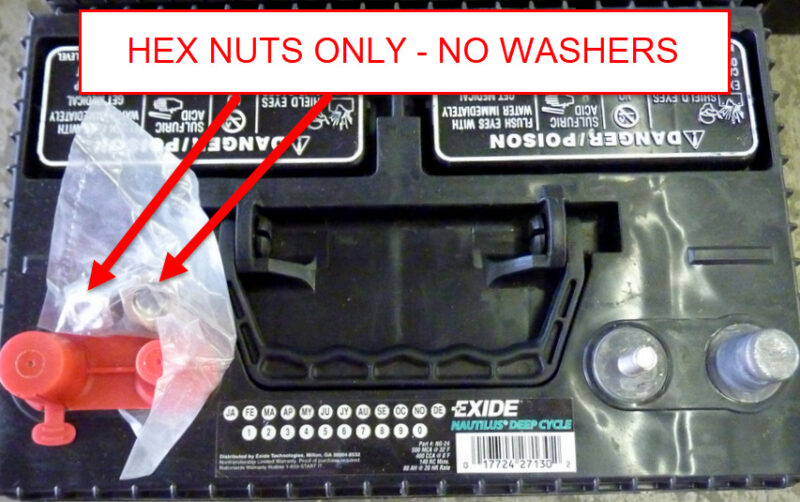
East Penn / Deka Marine Battery:
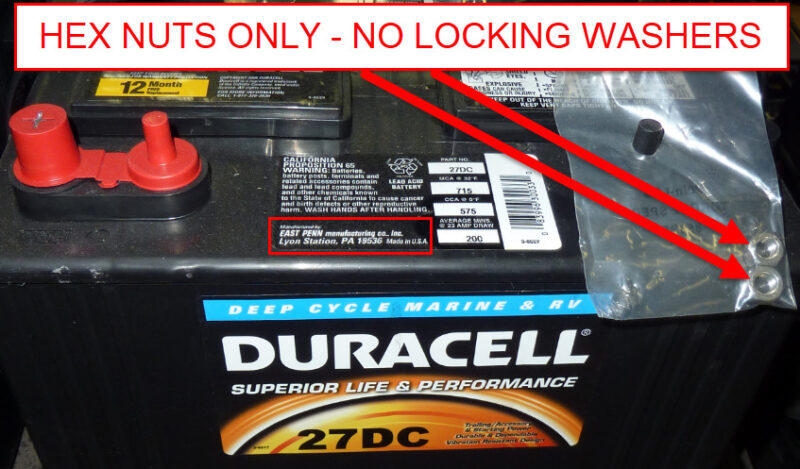
Exide and East Penn/Deka/Duracell (East Penn licenses the Duracell name) own a huge percentage of the marine market yet neither bothers to ship any locking mechanism. How is it that replacing a standard hex nut (no washer) with a Nylock is “worse” or “less safe”, than what these manufacturers ship batteries with? The answer is clear, a Nyloc nut would be safer than just a hex nut. I agree that these SS hex nuts are far superior to “wing nuts” but cutting corners on a locking mechanism is just poor form. I have many other images of “marine batteries” that do not ship with locking washers but, I won’t boor you. The way most batteries ship, without any locking washers, your failure mode is just one failure point, improper torque. Add a Nyloc and you now need two failures before anything bad could happen. Add a locking washer on top of a Nyloc and now you’d need three failures.
There are however a good number of premium battery battery makers, who actually do supply locking washers, such as;
- Odyssey
- Northstar
- Firefly
- Victron
- Full River
- Rolls
- Lifeline
- Mastervolt
- Lithionics
Plus just about every LiFePo4 prismatic cell manufacture I know of. All the batteries brands I just mentioned can deliver MASSIVE amounts of short circuit current into a dead short.
How many installers or folks that DIY do you suppose add any locking washer or Nyloc nut beyond what the battery manufacturer supplied the battery with? From our observations, as a marine electrical business, I can say that this number is about as close to 1% as it gets. A nut only may be okay, if the nuts are properly torqued, (each manufacturer provides a torque spec), the cable is properly strain relieved, and the battery physically can’t move, but I rarely see that. The ABYC standards actually allow for batteries to move slightly, up to 1″, and this is why some level of locking is considered a best practice.
A Simple and Honest Question:
Would using a Nyloc nut be worse than what many battery manufacturers shipped the battery with, if it’s a plain hex nut or wing nut?
Answer = NO! Adding a Nyloc is a level of safety beyond a standard hex nut or wing nut.
In this melted battery case, the Nyloc nut was still well “locked“, despite the battery case physically melting due to high resistance. I’d have to vote for the Nyloc certainly being better than no locking mechanism at all.
Why does all this matter?
Before your Nyloc nut can melt, the battery will have likely already begun to melt, as it did here. Even if you somehow exceeded the 284F, and and your battery has not exploded, and the Nyloc nut failed to perform its locking feature, this can only be considered a secondary failure when compared to what most batteries ship with. Before we can even get to a Nyloc failure, we would still need to have a primary failure or a nut torque failure first.
In this case we had a primary failure mode, lack of proper nut torque, which lead to high resistance and then to the battery case melting and the heat shrink melting. A physically melted battery case, and the heat shrink melted and yet a secondary failure of the Nyloc nut still did not occur.
We would need two failure modes to have the actual failure of a Nyloc nut. A melted Nyloc and and an improperly torqued nut to begin with. Based on the factual data, including melting points, this suggests that before this Nyloc nut would have failed the battery case would have been so melted the owner would have been alerted to something, such as a fire or acid all over his vessel, well before the Nyloc nut became an issue.
Items That Melt Before the Nyloc:
– The battery Case
– Heat Shrink
– Solder
– Wire Jacket
But the Nyloc is the one that gets the bad rap by “docksperts“(dock experts)on the net??
In our business we see thousands of battery posts every year with no locking mechanismt all. Do we carry lots of 5/16″ and 3/8″ lock washers and 5/16″ and 3/8″ nuts, & wire ties, you bet we do. We also however carry a lot of 5/16″ and 3/8″ Nylocs too. and in cases of short battery posts, such as Trojan batteries. We also carry flanged self-locking nuts also called Wizz nuts. We go through multiple boxes of 100 each of lock washers and Nyloc 5/16″ and 3/8” nuts every year.
My personal preference here is to use a locking washer when ever I can, but when it won’t fit, I have no issues using a properly torqued Nyloc nut on a battery terminal.
Why Do Battery Manufacturers use Stainless Nuts and Posts if Stainless Steel is a Poor Conductor?
The answer to this is simple. The connection to the battery is between the lug and lead not the SS fasteners or SS posts. The nuts and posts are only there to provide compression and resist corrosion. Stainless is a fine solution to accomplish this.
How often do I see regular hex nuts, like price-point sensitive battery manufactures ship the product with, that lack a locking washer, actually come loose? Not all that often but, I do see it.. When I do, there are often signs or evidence they were tightened by a pair of pliers, as was the case here.
When tightened with a wrench, & properly torqued, it’s actually pretty rare to see a loose standard nut, even without a locking washer, come loose. When I do see this the battery installation has been sloppy, allowed too much battery movement and had sub-optimal strain relief for the large gauge wire. The key words are “properly torqued“. Properly torqued is the reason the ABYC, USCG & marine industry has moved away from allowing wing-nuts.
Boat owners and sloppy marine techs far to often opt to not to use a wing nut wrench or pliers to apply the proper torque. They improperly believe proper torque means with thumb and fore finger. It’s simply not possible to properly torque a wing nut with your thumb and fingers. It is also not advisable to torque standard nuts with a pair of cheap pliers. Would you torque your vehicles lug nuts with pliers………..??
I can personally point to numerous instances of loose wing nuts, but not a single case where a Nyloc came free because it melted and then vibrated loose. In almost every case of a wing nut coming loose it was because the installer made the nuts “finger tight” which is a far cry from properly torqued..
It’s also interesting to note that the ABYC safety standards specifically prohibit wing nuts above 6GA wire but they make no such prohibition for Nyloc nuts.
My only point here is to suggest that I would prefer to see a Nyloc used rather than the option of a regular nut with no lock washer or a wing nut with no lock washer. My first preference, if it will fit the post, is for a Nyloc nut and locking washer, second choice would be a hex nut with lock washer, as many premium battery makers ship with. A Wizz nut would be a third choice. The fourth choice a regular nut without a locking washer. All of these choices, of course, properly torqued.
Unfortunately, there are situations where a regular nut height, or even a half-height nut is all that will fit on the post & Trojan Battery is notorious for supplying extremely short posts. In this case proper torque and the use of a Wizz/Serrated Flange Nut nut is a must. A standard Wizz nut is the same height as a standard nut but has a built in serrated locking washer.
CAUTION: Using Wizz nuts for batteries that will be decommissioned each winter can reduce the thickness of the lug over time. The reversing of a properly torqued Wizz nut causes copper and tin plating on the terminal to be removed more so than that of a standard locking washer/flat washer combo or a Nyloc/flat washer combo. You can out a flat washer under a Wizz nut but the entire point of a Wizz nut being used is due to a lack of battery terminal height.
Rant officially over…. (smile)
It Actually Got Hot Enough To Melt The Heat Shrink
This lug got very, very hot, hot enough to physically melt adhesive lined heat shrink. Even my industrial grade Milwaukee heat gun has never melted heat shrink like this.
It should also be noted that this battery was protected by a 200A ANL fuse. The fuse and holder are perfectly fine and never blew. Why? Fuses won’t and can’t protect against high-resistance which is what caused this situation. A high-resistance situation can start a boat fire at well below a fuses trip rating.
Huston, We Have a Problem…!
Here’s the other half of this problem. The first half was caused by improper torquing of the Nyloc nut with pair of pliers. Please DO NOT use pliers to tighten and torque battery terminals.
The second problem arose because the person who connected these batteries left the flat SS washer on top of the lead battery post. This means the SS wahser was sandwiched between the lug and the lead of the battery post. Stainless steel is a horrible conductor, one of the worst.
In battery installations flat washers should never be placed between the lug and battery post. They can only ever reside on top of the lug compressing it not being compressed.
Here’s the relevant ABYC standards from E-10 Storage Batteries:
“10.8.3 Battery cables and other conductors size 6 AWG (13.3 mm²) and larger shall not be connected to the battery with wing nuts.
10.8.4 Multiple conductors connected to a battery shall be installed with the highest ampacity conductor terminal closest to the battery, followed by successively smaller ampacity conductor terminals.
10.8.4.1 A maximum of four conductor terminals shall be permitted to be installed on a single battery stud.
10.8.5 Flat washers, if used, shall only be installed immediately under the split lock washer and nut of the attachment stud.”
The Case & Post
Here’s another shot, and close up, of the melting of the plastic case around the positive post. This battery will now be retired because its ability to hold electrolyte may have been compromised. We have no way to see inside, to inspect actual damage to the electrolyte post seal, so as a safety precaution this battery will be recycled, even though it still tests fine. Sad really.
If you click on the photo, and look closely, this terminal does not appear to have been cleaned before the terminals were re-connected in the spring. There are signs of “hot spots” in the lead and what appears to be some melting close to the stud too.
This termination point was creating tremendous resistance and lots of heat thanks to a combination of not just one, or two terminal installation errors but a third as well. The third failure mode here is that poor cleaning and housekeeping of the terminals themselves was evident.
Another View
Here’s another view of the physical melting, of the battery case, around the base of the post. It should not look like this. Issues like this can start small but can quickly become quite problematic, especially if left unchecked.
Please keep a watchful eye when connecting and disconnecting your battery banks for anything unusual.
I apologize for the poor quality photos. The lighting on this boat was rather pretty poor.
Lock Washers
This particular battery is an extremely high current capable AGM variant called TPPL or thin plate pure lead. This Odyssey, a single group 31, can deliver 5000A of current into a dead short. You really don’t want your connections loose on a battery like this. EnerSys, the parent company of Odyssey, thinks it’s important enough to include a “locking mechanism” or lock washer with their product as do many other premium battery manufactures. In this image the kit is still taped to the battery as it shipped.
Trojan Battery Document
This image is from a document I received at a Trojan Battery training seminar at a solar conference. In this document Trojan is saying exactly what myself and the ABYC standards say. You can not place a washer between the lead or brass battery terminal and the cable lug because it creates a high resistance point which can lead to a melt down.
Also note where Trojan Battery is showing the use of lock washers despite only currently including washers with their Reliant AGM batteries. Perhaps the lack of a locking washer, on some of their flooded products, is due to the “shrinking post syndrome” some of their batteries have been suffering from that feature the ELPT (embeded low profile post) terminals.
In this image and illustration we can actually see where the ABYC weighs in as highlighted in yellow.
Really? C’mon Wrenches are not That Expensive… Doh’
I am sorry but a 3/8 nut should not look like this. The wrench was invented over 180 years ago so that we can properly tighten nuts. A set of pliers is not the same as a wrench.
I have no idea what type of pliers or tools were used to install this nut, perhaps even a pair of lobster shell crackers, but it was simply not done properly or safely.
Please be careful out there. It only takes a few moments of inattention, or some poor practices, to get your boat burned to the waterline. This disaster waiting to happen, was narrowly averted and no amount of over-current protection would have prevented a full meltdown if this had been allowed to persist.
Be safe out there!
Let’s Keep This Site Running!
Like what you saw or read? Would you like to see more articles like this? Is so feel free to donate, support the site and keep it growing. I am trying my hardest to keep this information FREE. If you liked it, learned from it or I saved you some money feel free to make a small donation, that’s all I ask.

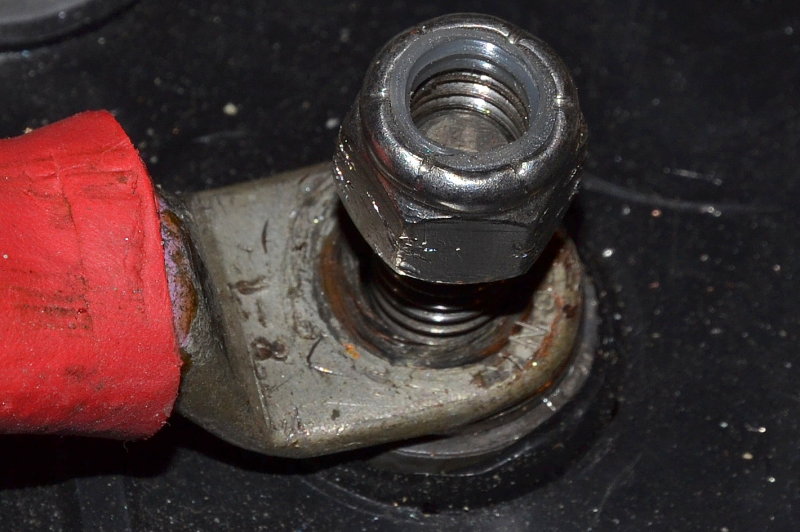

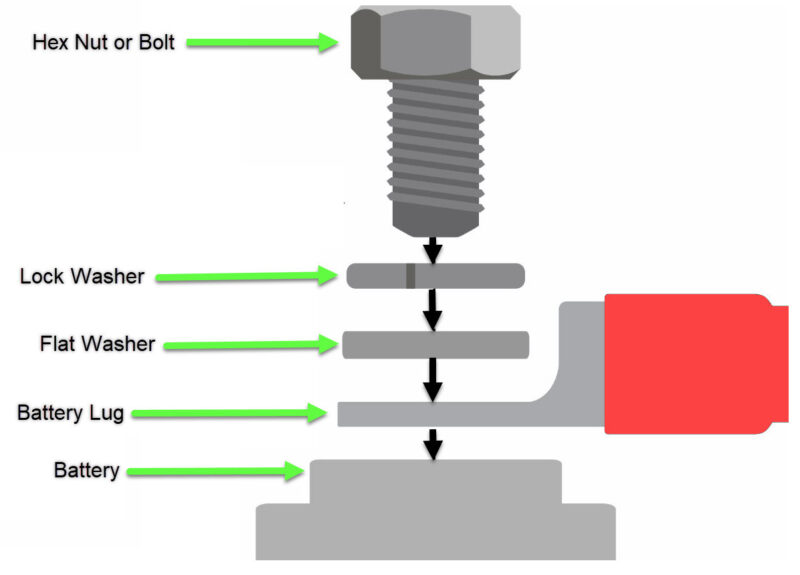
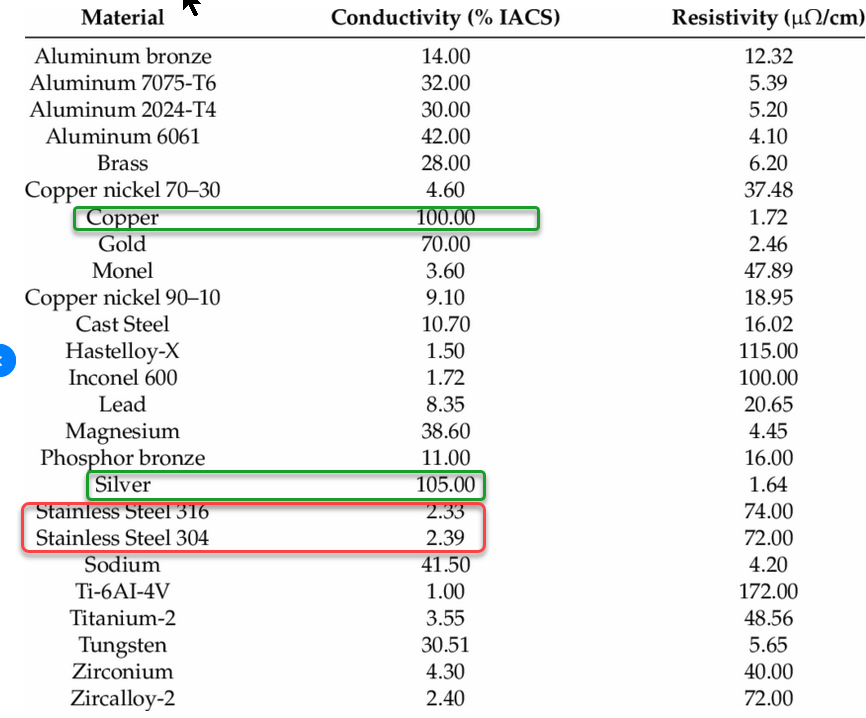

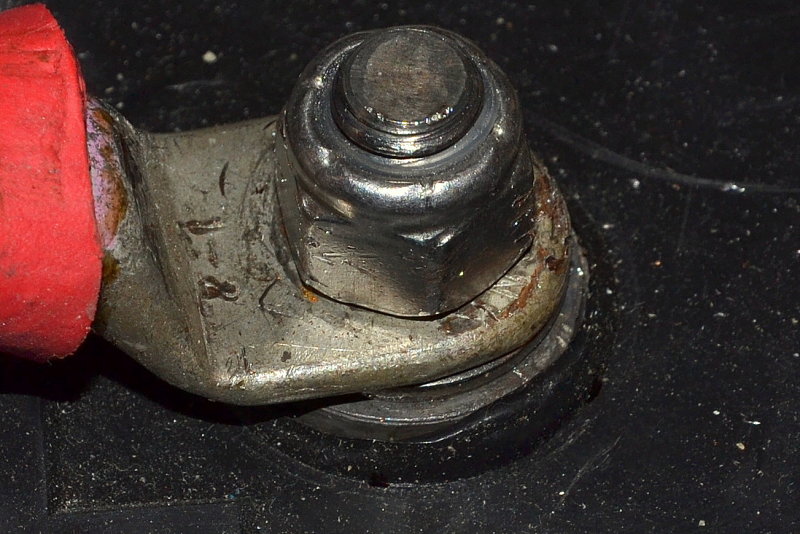
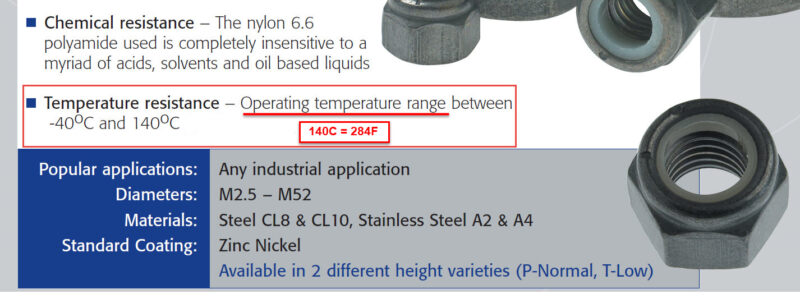
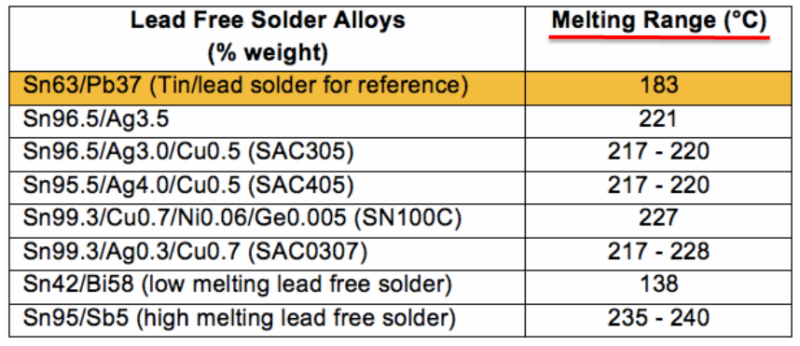


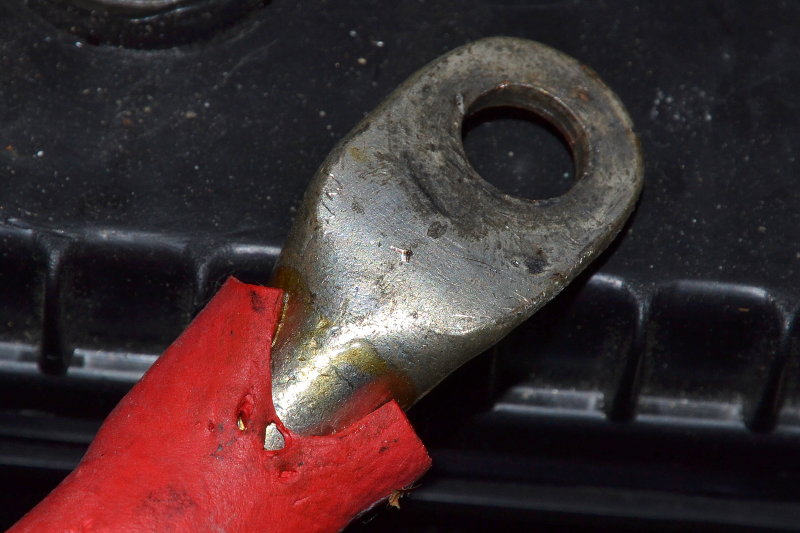
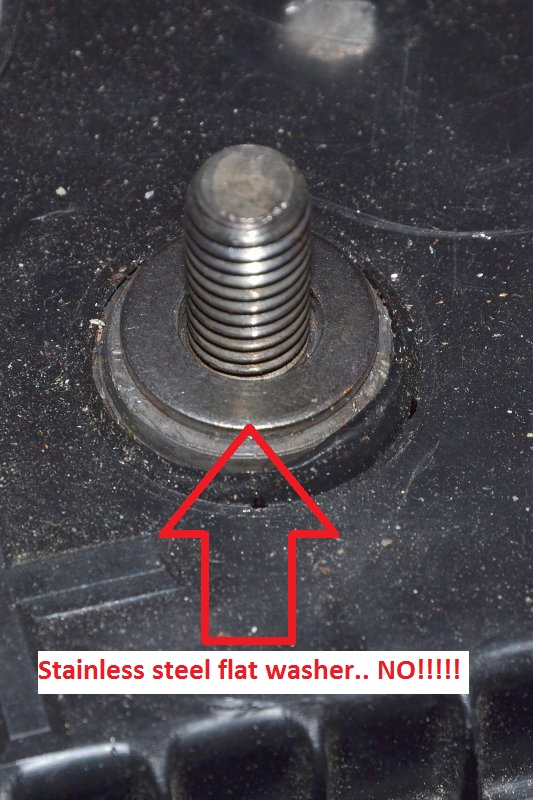
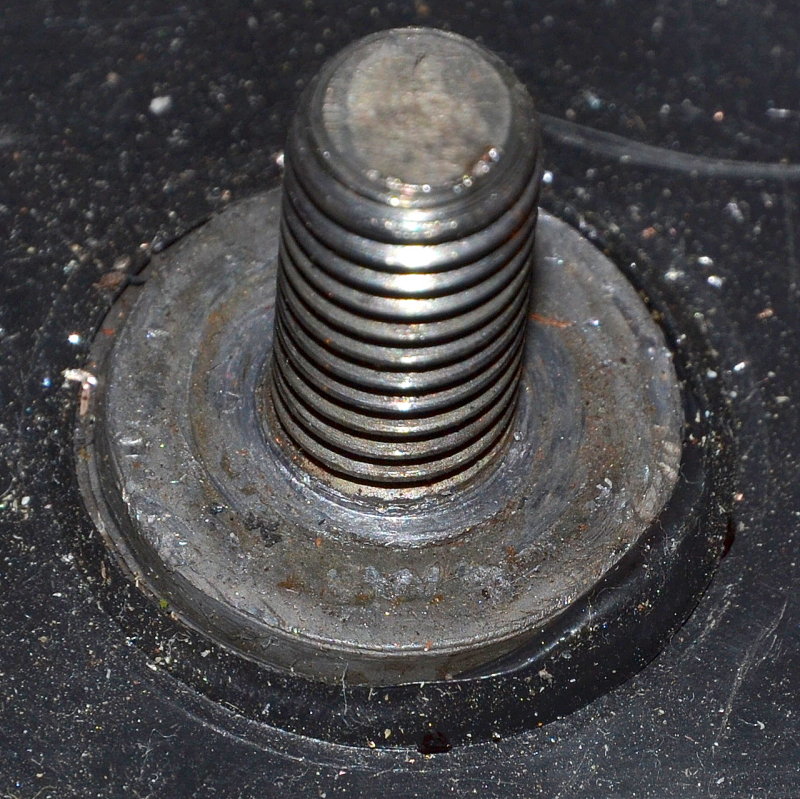
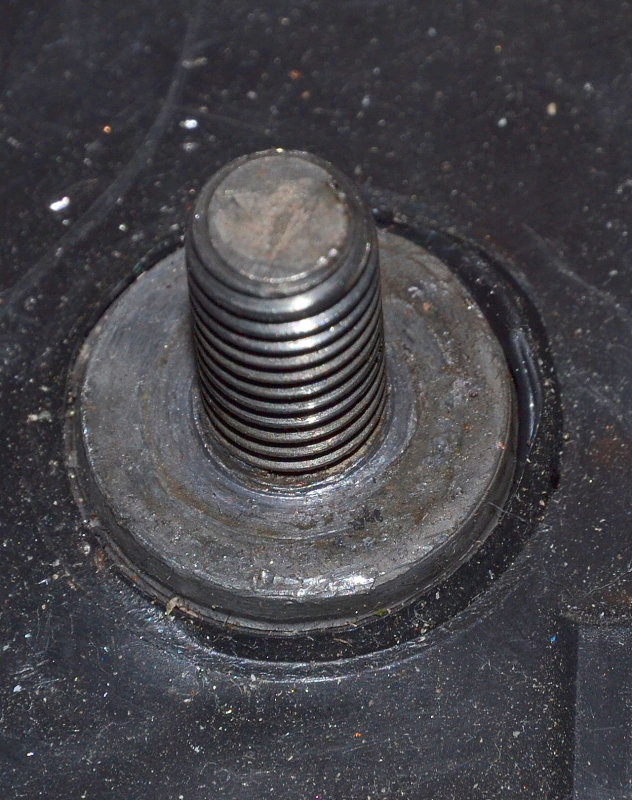
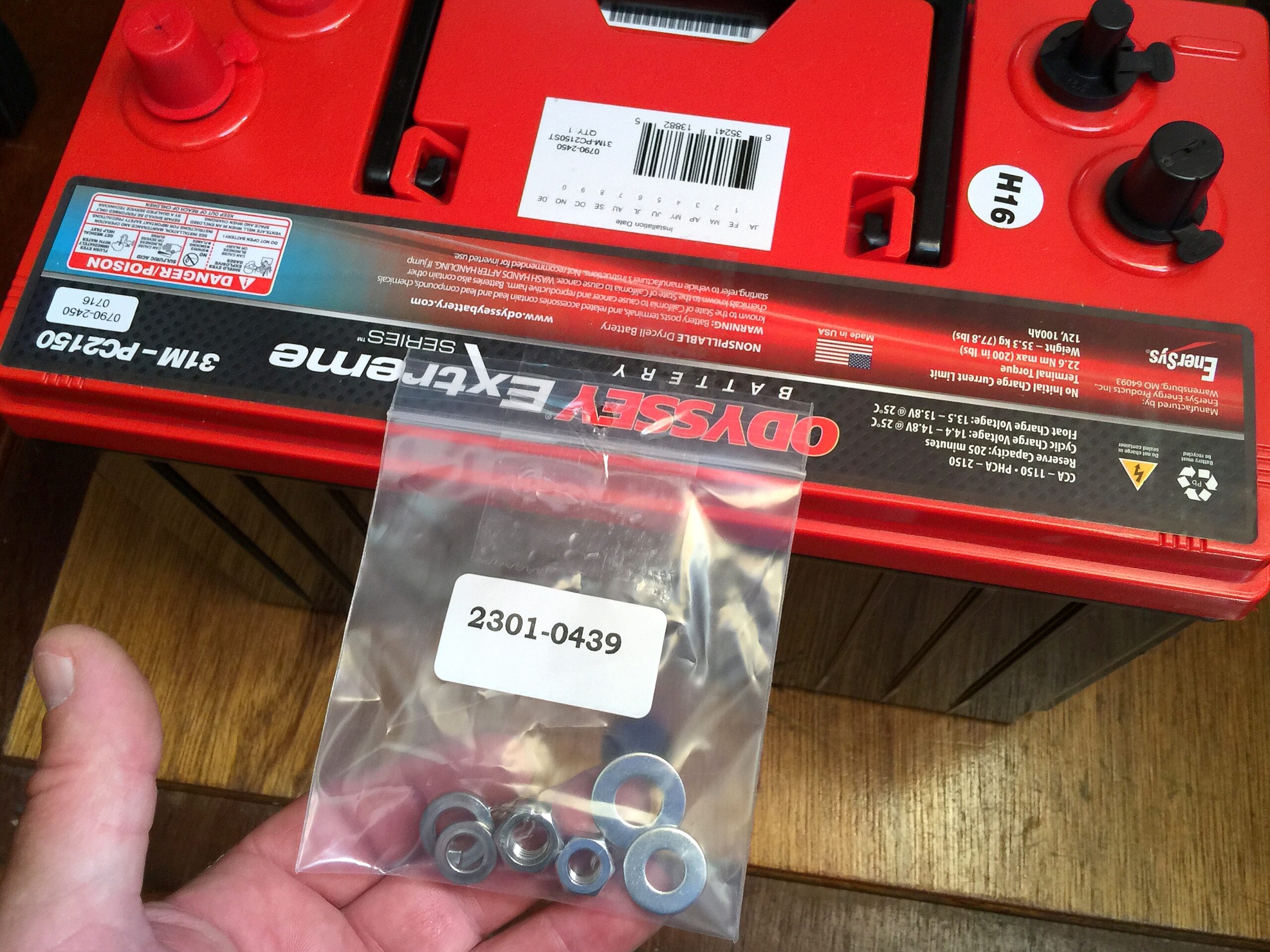

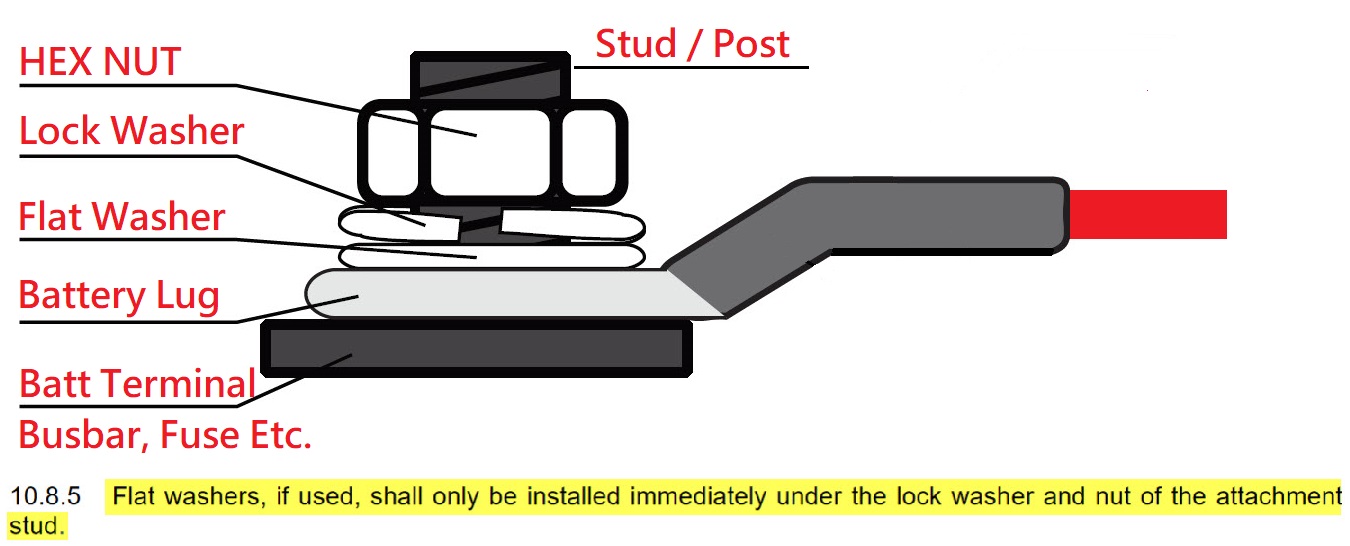
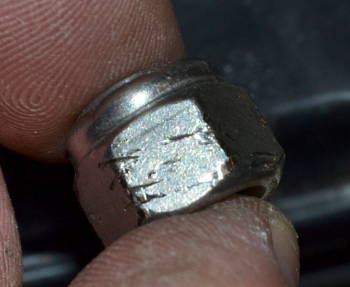
Interesting article – thank you. I’m reading since I’m about to install a bank of LiFePo and I intend to go over my complete system and clean all connectors and terminals on the large cables. I’d be interested in your comments on cleaning technique and if particular compounds should be used to keep the oxygen out of the completed connection.